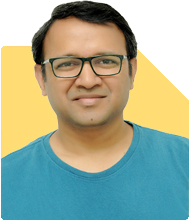41-Year-Old Seeking 1 Cr+ Retirement Corpus with 25K SIP: Is It Achievable?
Ramalingam Kalirajan |9854 Answers |Ask -Follow
Mutual Funds, Financial Planning Expert - Answered on Sep 10, 2024
He has an MBA in finance from the University of Madras and is a certified financial planner.
He is the director and chief financial planner at Holistic Investment, a Chennai-based firm that offers financial planning and wealth management advice.... more

Hello Dev, I m 41 Y working in a Pvt org and planning to retire by 55. I haven't invested in MF yet. Currently I hv only my EPF, PPF & NPS apart from Life, Term & Health Insurance. I want to invest 25K per month for 15 yrs with an aim to accumulate 1Cr+. I am OK with moderate to high risks as I don't have immediate liquidity commitments at least for 10 yrs from now. Pls suggest the best SIP breakup where I can invest? Thank You.
Investing Rs 25,000 monthly over the next 15 years to accumulate Rs 1 crore is an achievable goal with disciplined investment in well-allocated mutual funds. This duration and your risk tolerance give you the opportunity to take advantage of equity-based investments, which generally provide higher returns over the long term.
Evaluating Mutual Fund Options
To meet your goal of accumulating Rs 1 crore or more, an ideal approach would involve diversifying across different categories of mutual funds. This ensures that you balance risk and returns efficiently while taking full advantage of market opportunities. Here are some categories you should consider for your SIP:
Equity Mutual Funds: These are essential for wealth creation due to their potential for higher returns over the long term. Equity mutual funds invest in stocks, which, despite market volatility, tend to perform well over extended periods. Since you have a 15-year horizon, equity funds should form the core of your portfolio.
Balanced or Hybrid Funds: While equity funds offer higher growth, balanced or hybrid funds provide a good mix of both equity and debt instruments. This gives your portfolio a cushion against market volatility while still generating decent returns. These funds are excellent for risk mitigation, and their stable performance ensures steady growth.
Flexi-Cap Funds: These funds have the flexibility to invest across large-cap, mid-cap, and small-cap stocks, allowing fund managers to make decisions based on market conditions. They provide a dynamic approach to tapping into the market’s growth potential.
Small-Cap and Mid-Cap Funds: These funds are known for delivering high returns over the long term, although they carry higher risk. As you are comfortable with moderate to high risk, allocating a portion to these funds could significantly boost your portfolio’s performance.
Disadvantages of Index Funds and Benefits of Actively Managed Funds
Many investors tend to lean towards index funds due to their low cost and passive nature. However, in your case, actively managed funds would be more beneficial for several reasons.
Index Funds: While they mirror market indices, they lack flexibility. Index funds cannot adapt to changing market conditions or seize specific growth opportunities that an actively managed fund can. This can lead to missed opportunities for higher returns, especially during times of market volatility or in sectors experiencing high growth.
Actively Managed Funds: These funds, managed by experienced fund managers, have the potential to outperform the market. They continuously assess market trends, sectors, and individual stocks to maximize returns. This active involvement often results in better long-term growth, particularly when combined with your high-risk tolerance and long-term investment horizon.
Why Regular Funds are Better Than Direct Funds
Choosing to invest in regular funds through a Mutual Fund Distributor (MFD) or Certified Financial Planner (CFP) has several advantages. You gain access to professional guidance and insights that help align your investments with your financial goals.
Regular Funds: When you invest in regular funds, you receive ongoing support from a Certified Financial Planner. They monitor your portfolio and provide advice on when to rebalance or switch funds based on market performance and your changing financial needs. This ensures that you stay on track to meet your retirement goal of accumulating Rs 1 crore.
Direct Funds: These may seem cost-effective initially since they don’t involve commission fees. However, you lose the benefit of expert guidance. Without professional support, you may struggle to optimize your portfolio, especially during volatile market phases. The absence of strategic rebalancing and insight could result in lower overall returns over the long term.
Suggested SIP Allocation for Your Goal
Based on your requirement to invest Rs 25,000 monthly for 15 years, the portfolio should be diversified to balance growth and stability. Here’s a suggested allocation:
Large-Cap Funds (30%): These funds invest in well-established companies with a strong track record of performance. They provide stability to the portfolio and reduce overall risk while still delivering growth. The lower volatility makes them ideal for long-term wealth building.
Flexi-Cap Funds (30%): As discussed earlier, these funds offer flexibility in capitalizing on growth across different market segments. They are excellent for capturing the best opportunities across market capitalizations.
Mid-Cap and Small-Cap Funds (25%): These funds should form a significant portion of your portfolio, as they have the potential to deliver high returns. Given your long investment horizon and higher risk tolerance, investing in mid-cap and small-cap funds will help your portfolio grow faster.
Balanced/Hybrid Funds (15%): To mitigate risk, adding a small portion of balanced funds will provide stability, especially during periods of market downturn. This allocation ensures that your portfolio doesn’t experience sharp declines while still benefiting from equity growth.
Ensuring Portfolio Growth Over Time
Consistent performance monitoring is crucial to ensure that your investments remain aligned with your goal of Rs 1 crore.
Annual Review: It’s important to review your portfolio annually and make adjustments based on market conditions and your evolving financial goals. A Certified Financial Planner can help rebalance the portfolio as required. This ensures that the investments continue to perform optimally.
SIP Step-Up: As your income grows, you can consider increasing your SIP amount every year. This strategy, often referred to as a ‘SIP Step-Up,’ helps in significantly increasing the corpus without making a substantial impact on your lifestyle. Even a small increase in your SIP amount can accelerate your journey towards Rs 1 crore.
Market Volatility: Since your risk tolerance is moderate to high, you should be prepared for market fluctuations. However, staying invested for the entire 15 years will help smooth out any short-term market volatility. Over time, the equity markets have shown resilience and growth, particularly when viewed from a long-term perspective.
Tax Efficiency and Rebalancing
As your investment corpus grows, it’s also essential to keep tax efficiency in mind. Since your investments will likely generate substantial returns, you must be mindful of the tax implications.
Long-Term Capital Gains Tax (LTCG): In India, LTCG on equity mutual funds is applicable after one year of holding. Gains over Rs 1.25 lakh in a financial year are taxed at 12.5%. Since your time horizon is long-term, this tax may come into play. Proper planning with a Certified Financial Planner can help manage this effectively.
Rebalancing for Tax Efficiency: Rebalancing your portfolio periodically helps in maintaining the ideal asset allocation. It also allows you to minimize tax outflows by utilizing tax-efficient strategies. For example, when shifting from equity funds to balanced funds as you near retirement, tax implications can be managed better with professional guidance.
Final Insights
Investing Rs 25,000 per month for 15 years is a well-thought-out plan. Your risk tolerance and long-term view make equity-based mutual funds an ideal choice.
By opting for actively managed funds, guided by a Certified Financial Planner, you can optimize your portfolio for better returns. The right mix of large-cap, flexi-cap, mid-cap, and hybrid funds will help you achieve your Rs 1 crore goal while managing risk.
Additionally, regular reviews and strategic rebalancing will ensure that your portfolio remains on track, regardless of market conditions.
Finally, ensure you remain disciplined with your SIPs and consider stepping up your contribution over time for faster wealth accumulation.
Best Regards,
K. Ramalingam, MBA, CFP,
Chief Financial Planner,
www.holisticinvestment.in
You may like to see similar questions and answers below
Omkeshwar Singh | Answer |Ask -Follow
Head, Rank MF - Answered on Sep 08, 2021
Ramalingam Kalirajan |9854 Answers |Ask -Follow
Mutual Funds, Financial Planning Expert - Answered on May 26, 2024
Ramalingam Kalirajan |9854 Answers |Ask -Follow
Mutual Funds, Financial Planning Expert - Answered on May 18, 2024
Ramalingam Kalirajan |9854 Answers |Ask -Follow
Mutual Funds, Financial Planning Expert - Answered on May 21, 2024
Ramalingam Kalirajan |9854 Answers |Ask -Follow
Mutual Funds, Financial Planning Expert - Answered on Aug 21, 2024
Dr Dipankar Dutta |1783 Answers |Ask -Follow
Tech Careers and Skill Development Expert - Answered on Jul 28, 2025
Dr Dipankar Dutta |1783 Answers |Ask -Follow
Tech Careers and Skill Development Expert - Answered on Jul 28, 2025
Dr Dipankar Dutta |1783 Answers |Ask -Follow
Tech Careers and Skill Development Expert - Answered on Jul 28, 2025
Dr Dipankar Dutta |1783 Answers |Ask -Follow
Tech Careers and Skill Development Expert - Answered on Jul 28, 2025
Dr Dipankar Dutta |1783 Answers |Ask -Follow
Tech Careers and Skill Development Expert - Answered on Jul 28, 2025
Dr Dipankar Dutta |1783 Answers |Ask -Follow
Tech Careers and Skill Development Expert - Answered on Jul 28, 2025
Dr Dipankar Dutta |1783 Answers |Ask -Follow
Tech Careers and Skill Development Expert - Answered on Jul 28, 2025
Patrick Dsouza |1336 Answers |Ask -Follow
CAT, XAT, CMAT, CET Expert - Answered on Jul 27, 2025
Patrick Dsouza |1336 Answers |Ask -Follow
CAT, XAT, CMAT, CET Expert - Answered on Jul 27, 2025
Nayagam P P |9494 Answers |Ask -Follow
Career Counsellor - Answered on Jul 27, 2025






















